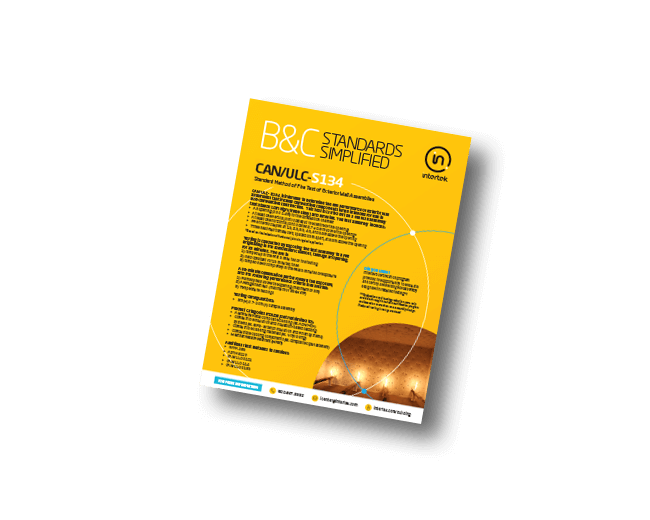CAN/ULC S134: Standard Method of Fire Test of Exterior Wall Assemblies
Standard: CAN/ULC S134 – Standard Method of Fire Test of Exterior Wall Assemblies
Certification Required: While the Canadian Building Code only requires exterior wall assemblies containing combustible cladding to be evaluated to CAN/ULC-S134, optional enrollment in a certification and listing program offers many advantages in terms of product marketing, ease of system specification, clarity of system application, ease of documentation and installation inspection, etc.
Scope: Evaluates the performance of an exterior wall assembly in a simulated post flashover fire with compartment venting through an opening in the wall. The test method assesses exterior flame spread, heat flow to exterior surface, fire spread within test specimen. The test does not address framing details or treatment of openings (doors, windows), interior fire exposure effects, or loadbearing capabilities.
Applicable Products: Exterior wall assemblies that contain combustible materials.
Test Procedure: An exterior wall assembly is constructed onto the front face of the test apparatus. This test replicates, in full scale, a post flashover fire in a compartment venting through a window opening. The fire plume exposes the outer face of the test specimen. The furnace is operated to reproduce the gas flow, determined by apparatus calibration, to achieve a specific heat flux on the exterior wall face. The gas flow ramp to target over five minutes, holds target for fifteen minutes, then ramps down to no flow over five minutes. Depending on the properties of the test specimen, the area involved in burning may increase, remain without substantial change or decrease as the combustible material of the specimen has been consumed. The performance of the specimen is rated by the extent of the flame front above the opening, as well as by the additional heat flow to the wall at a specified distance above the opening. These performance ratings are deemed to reflect the potential of spread of fire to stories above the story of fire origin as a result of the presence of combustible materials in an exterior wall assembly.
End Result: Determination of passing result indicates that the flaming on the front wall face did not exceed 5 m above the window opening and the average heat flux at all three measured locations 3.5m above the window opening remained below 35 kW.m2. A comprehensive test report will be issued at the end of the conclusion of testing. If certification is chosen, the Listing Report and application Design Listings will be created and published following successful testing.
Intertek Testing Locations: Elmendorf, TX
View our Standards Simplified fact sheet on CAN/ULC-S134, the Standard Method of Fire Test of Exterior Wall Assemblies. You will also gain access to our exclusive Infographic that walks you through learning when CAN/ULC-S134 may be needed.
